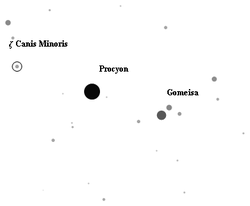Zeta Canis Minoris
 Star map of the 25 brightest stars in Canis Minor. Zeta Canis Minoris is circled. | |
| Observation data Epoch J2000 Equinox J2000 | |
|---|---|
| Constellation | Canis Minor |
| Right ascension | 07h 51m 41.98835s[1] |
| Declination | +01° 46′ 00.7395″[1] |
| Apparent magnitude (V) | 5.03[2] |
| Characteristics | |
| Spectral type | B8II[2] |
| U−B color index | -0.48[3] |
| B−V color index | -0.13[3] |
| Astrometry | |
| Radial velocity (Rv) | 32.3[2] km/s |
| Proper motion (μ) | RA: -14.43[1] mas/yr Dec.: -2.40[1] mas/yr |
| Parallax (π) | 5.23 ± 0.36[1] mas |
| Distance | 620 ± 40 ly (190 ± 10 pc) |
| Absolute magnitude (MV) | -1.27 |
| Other designations | |
| Database references | |
| SIMBAD | data |
Zeta Canis Minoris (ζ CMi, ζ Canis Minoris) is a star in the constellation Canis Minor.
ζ Canis Minoris is a blue-white B-type bright giant with an apparent magnitude of +5.13. It is approximately 420 light years from Earth.
References
- 1 2 3 4 5 van Leeuwen, F. (2007). "Validation of the new Hipparcos reduction". Astronomy and Astrophysics. 474 (2): 653–664. Bibcode:2007A&A...474..653V. arXiv:0708.1752
 . doi:10.1051/0004-6361:20078357. Vizier catalog entry
. doi:10.1051/0004-6361:20078357. Vizier catalog entry - 1 2 3 "zet CMi". SIMBAD. Centre de données astronomiques de Strasbourg. Retrieved 28 December 2016.
- 1 2 Mermilliod, J.-C. (1986). "Compilation of Eggen's UBV data, transformed to UBV (unpublished)". Bibcode:1986EgUBV........0M.
This article is issued from
Wikipedia.
The text is licensed under Creative Commons - Attribution - Sharealike.
Additional terms may apply for the media files.